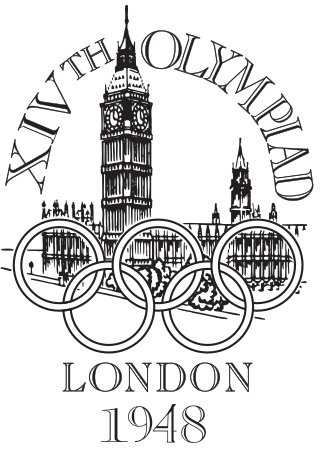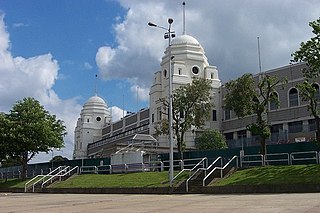
The 1948 Summer Olympics, officially the Games of the XIV Olympiad and officially branded as London 1948, were an international multi-sport event held from 29 July to 14 August 1948 in London, United Kingdom. Following a twelve-year hiatus caused by the outbreak of World War II, these were the first Summer Olympics held since the 1936 Games in Berlin. The 1940 Olympic Games had been scheduled for Tokyo and then for Helsinki, while the 1944 Olympic Games had been provisionally planned for London. This was the second time London hosted the Olympic Games, having previously hosted them in 1908, making it the second city to host summer olympics twice. The Olympics would return again to London 64 years later in 2012, making London the first city to host the games thrice, and the only such city until Paris, who hosted their third games in 2024, and Los Angeles, who will host theirs in 2028. The 1948 Olympic Games were also the first of two summer Games held under the IOC presidency of Sigfrid Edström.

Finland competed at the 1948 Summer Olympics in London, England. 129 competitors, 123 men and 6 women, took part in 84 events in 16 sports. As the country hosted the next Olympics in Helsinki, the flag of Finland is flown at the closing ceremony.
At the 1948 Summer Olympics in London, nine events in gymnastics were contested. Finland led all nations with six gold medals and ten medals overall.

The individual show jumping was an equestrian event held as part of the Equestrian at the 1964 Summer Olympics programme. The event was held on 24 October. There were 46 competitors from 17 nations. Each nation could have up to three riders. The event was won by Pierre Jonquères d'Oriola of France, the first rider to win two gold medals in individual jumping; he did so 12 years apart, with his first in 1952. It was France's third gold medal in the event overall, moving out of a tie with Italy at two for most all-time. Hermann Schridde, representing the United Team of Germany, took silver. Great Britain earned its second consecutive bronze in the event, this time with Peter Robeson taking the honors.

The men's triple jump event was part of the track and field athletics programme at the 1948 Summer Olympics. The competition was held on 3 August 1948. Twenty-eight athletes from 17 nations competed. The maximum number of athletes per nation had been set at 3 since the 1930 Olympic Congress. The final was won by Arne Åhman of Sweden. It was Sweden's first victory in the event since 1912, and first medal since 1932. Australia reached the podium for the second Games in a row with Gordon George Avery's silver. Turkey received a medal in its first appearance in the triple jump with Ruhi Sarialp's bronze; it was the only track and field athletics medal won by Turkey in the 1900s.

The men's high jump event was part of the track and field athletics programme at the 1948 Summer Olympics. The competition was held on July 30, 1948. Twenty-seven athletes from 16 nations competed. The maximum number of athletes per nation had been set at 3 since the 1930 Olympic Congress. The final was won by John Winter of Australia. It was Australia's first victory in the men's high jump, and only the second time a jumper from outside the United States had won. Bjorn Paulson earned Norway's first medal in the event with a silver. George Stanich took bronze, keeping alive the United States' streak of medaling in every edition of the men's high jump.

The men's pole vault event was part of the track and field athletics programme at the 1948 Summer Olympics. Nineteen athletes from 10 nations competed. The maximum number of athletes per nation had been set at 3 since the 1930 Olympic Congress. The competition was held on July 31 and August 2. During the final, a rainstorm came in during the jumps at 4.10. All the jumpers at 4.20 and higher had to deal with wet conditions on the runway and with their poles. The final was won by American Guinn Smith. Erkki Kataja had held the lead with a perfect set of jumps until Smith's last attempt clearance of 4.30. Smith's win was the United States' 11th consecutive victory in the men's pole vault. Kataja's silver was Finland's first medal in the event.

The men's decathlon event at the 1948 Olympic Games took place between August 5 and August 6. The 17-year-old Bob Mathias of the United States won with a points total of 7139.
The women's long jump event was, for the first time, part of the track and field athletics programme at the 1948 Summer Olympics. The competition was held on August 4, 1948. The final was won by Hungarian Olga Gyarmati.
The women's high jump event was part of the athletics programme at the 1948 Summer Olympics. The competition was held on 7 August 1948. The final was won by Alice Coachman of the United States who became the first black woman to win an Olympic gold medal.

A total of twenty-five sports venues were used to host the events of the 1948 Summer Olympics in London, United Kingdom. For the first time in the history of the modern Olympic Games, the diving, gymnastics, swimming, and water polo competitions were held indoors. These Games have since been nicknamed the "Austerity Games" for the tight control of costs at a time when the host nation was still under rationing, which resulted in a total expenditure of around £750,000. All of the venues were already in place and required only temporary modifications. The organizing committee decided not to build an Olympic Village; instead, foreign athletes were housed in makeshift camps at military bases and colleges around London, while local athletes were told to stay at home. Despite these measures, the combined venues of the 1948 Summer Olympics recorded the highest attendance figures for a Games at that time.
The individual dressage in equestrian at the 1948 Olympic Games in London was held in Aldershot from 9 to 10 August. Swiss rider Hans Moser won the gold medal. The silver was won by André Jousseaume of France and the bronze by Swedish rider Gustaf Adolf Boltenstern, Jr. The sixth place finisher, Gehnäll Persson, was disqualified when it was discovered that he was only a noncommissioned officer and thus ineligible to compete.
The team dressage in equestrian at the 1948 Olympic Games in London was held in the town of Aldershot on 9 August. The French team consisting of André Jousseaume, Jean Saint-Fort Paillard and Maurice Buret won the gold medal. The United States won silver and Portugal took bronze.
The individual eventing in equestrian at the 1948 Olympic Games in London was held in the town of Aldershot and at the Tweseldown Racecourse from 10 to 13 August. Bernard Chevallier of France won the gold medal. Frank Henry, from the United States, won silver and Robert Selfelt, from Sweden, took bronze. The team and individual eventing competitions used the same scores. Eventing consisted of a dressage test, a cross-country test, and a jumping test.
The team eventing in equestrian at the 1948 Olympic Games in London was held in the town of Aldershot and at the Tweseldown Racecourse from 10 to 13 August. The American team of Charles Anderson, Frank Henry and Earl Foster Thomson won the gold medal. Sweden won the silver medal and Mexico took bronze.

The individual show jumping in equestrian at the 1948 Summer Olympics in London was held at the Wembley Stadium on 14 August. The competition consisted of a single round of jumping. In the case of a tie in points, a jump-off was arranged. The jump-off had no time limit, however, the time taken to complete the jump-off was used as a tie-breaker. The points from the individual competition were also used in the team competition. There were 44 competitors from 15 nations, with nations able to send up to three riders each. The event was won by Humberto Mariles of Mexico, with his teammate Rubén Uriza taking silver at the top of a three-way jump-off for second place. Mariles' win was Mexico's first victory in the event. Jean-François d'Orgeix of France earned that nation's first individual jumping medal since 1928 with his bronze.

The individual eventing in equestrian at the 1956 Olympic Games in Helsinki was held from 30 July to 2 August. Only 34 of the 59 starters were able to finish the competition, with 20 being disqualified in the cross-country, 3 more retiring during that phase, and 2 being disqualified in the jumping.

The team eventing in equestrian at the 1952 Olympic Games in Helsinki was held from 30 July to 2 August. Only 33 of the 57 starters were able to finish the competition, with 19 being disqualified in the cross-country, 3 more retiring during that phase, and 2 being disqualified in the jumping. This left only 6 of the 19 teams with all three riders finishing.

The individual show jumping or "Prix des Nations" at the 1952 Summer Olympics took place on 3 August, at the Helsinki Olympic Stadium. It was the ninth appearance of the event. For the first time, the event featured two rounds. There were 51 competitors from 20 nations, with each nation able to send a team of up to three riders with the results shared between team and individual events. The event was won by Pierre Jonquères d'Oriola of France, the nation's first victory in individual jumping since 1912 and second overall. Óscar Cristi of Chile took silver for that nation's first medal in the event. German rider Fritz Thiedemann earned bronze.

The team jumping or Prix des Nations at the 1952 Summer Olympics took place on 3 August, at the Helsinki Olympic Stadium. It was the eighth appearance of the event. For the first time, the event featured two rounds.














